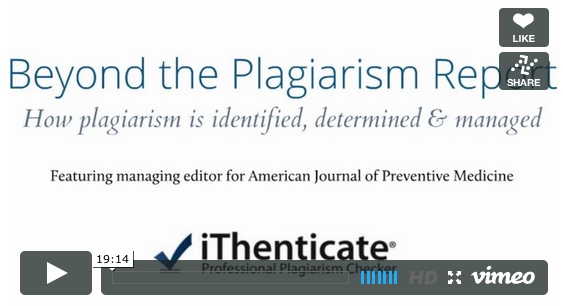

“ Self-plagiarism is commonly described as recycling or reusing one’s own specific words from previously published texts.

Research scientist Ben Mudrak states that like other forms of plagiarism, self-plagiarism can also be complicated and nuanced. Text recycling is confusing because it involves a person referencing their own prior work, rather than borrowing an abstract of someone else's text.
#Ithenticate self plagiarism how to
This type of inadvertent plagiarism is often the result of writers not understanding how to properly cite sources or paraphrase work.Īs conscientious writers avoid plagiarism through proper citation, they should also be aware of the potential for text recycling, also referred to as self-plagiarism. For example, a writer may cite a source at the end of a paragraph when it should be done at the end of a sentence.
#Ithenticate self plagiarism manuals
Since there are many different style manuals - AP, APA, Chicago and Harvard just to name a few - there are also as many standards concerning how and when a quote, passage or reference should be cited. Finally, plagiarism threatens the integrity of organizations where it occurs by making people question their legitimacy and ethics.Īs organizations become more vigilant against plagiarism, it’s important to realize the potential pitfalls individuals and organizations face if plagiarism isn’t detected in important reports, research papers and other government documents.Īccording to the Cambridge Dictionary, plagiarism is defined as, “The process or practice of using another person's ideas or work and pretending that it is your own.” Because plagiarism’s definition is a bit open-ended, there are many gray areas organizations must be aware of in order to avoid plagiarism.įor instance, the improper citation of sources can often lead to unintended plagiarism. Those accused of plagiarism may also face legal consequences, especially in the government sector. The most obvious negative repercussion resulting from instances of plagiarism is the damage to the personal reputations of those accused. When important government documents are plagiarized, the consequences can be devastating. Sensitive information pertaining to government technology, personal information and legal rights is often related in these documents, so it’s imperative that all documents are ethically produced and maintained. Writing and research play a major role in every branch of government as countless organizations produce documents and reports concerning laws, funding and action plans, among other things. The Consequences of Plagiarism for Government Organizations We will also explain how government organizations can maintain their high ethical and legal standards by ensuring the originality of their published content. In this article, we’ll examine what plagiarism is and how it can occur unintentionally. But thanks to the advent of innovative technologies, organizations now have new tools to efficiently check for plagiarism in multiple sectors of society. Traditionally, finding potential plagiarism involved manually reviewing countless manuscripts, a tedious and time-consuming process. While plagiarism itself is an issue, detecting it is an even greater challenge.

Plagiarism is also a problem in the corporate and government sectors. Contrary to common perception, the challenge of plagiarism and unoriginal work is not limited to academia.


 0 kommentar(er)
0 kommentar(er)
